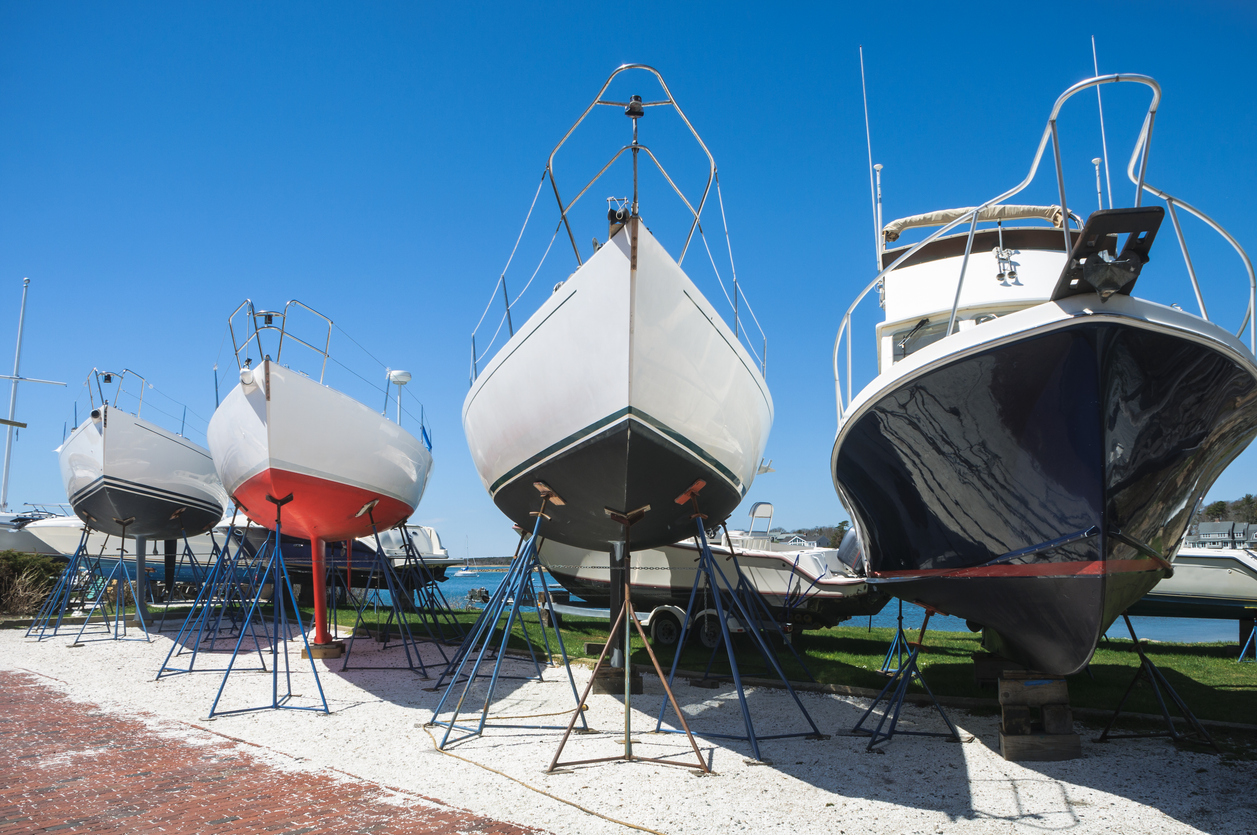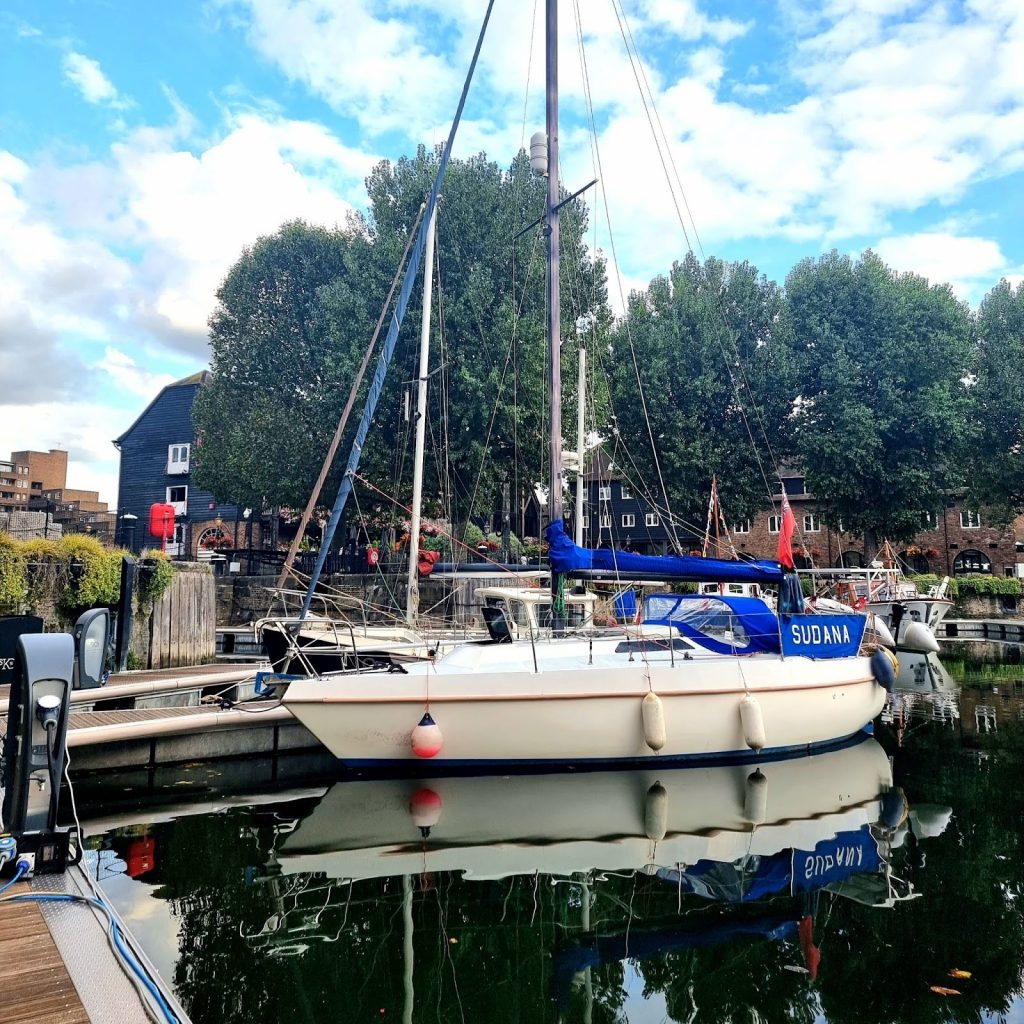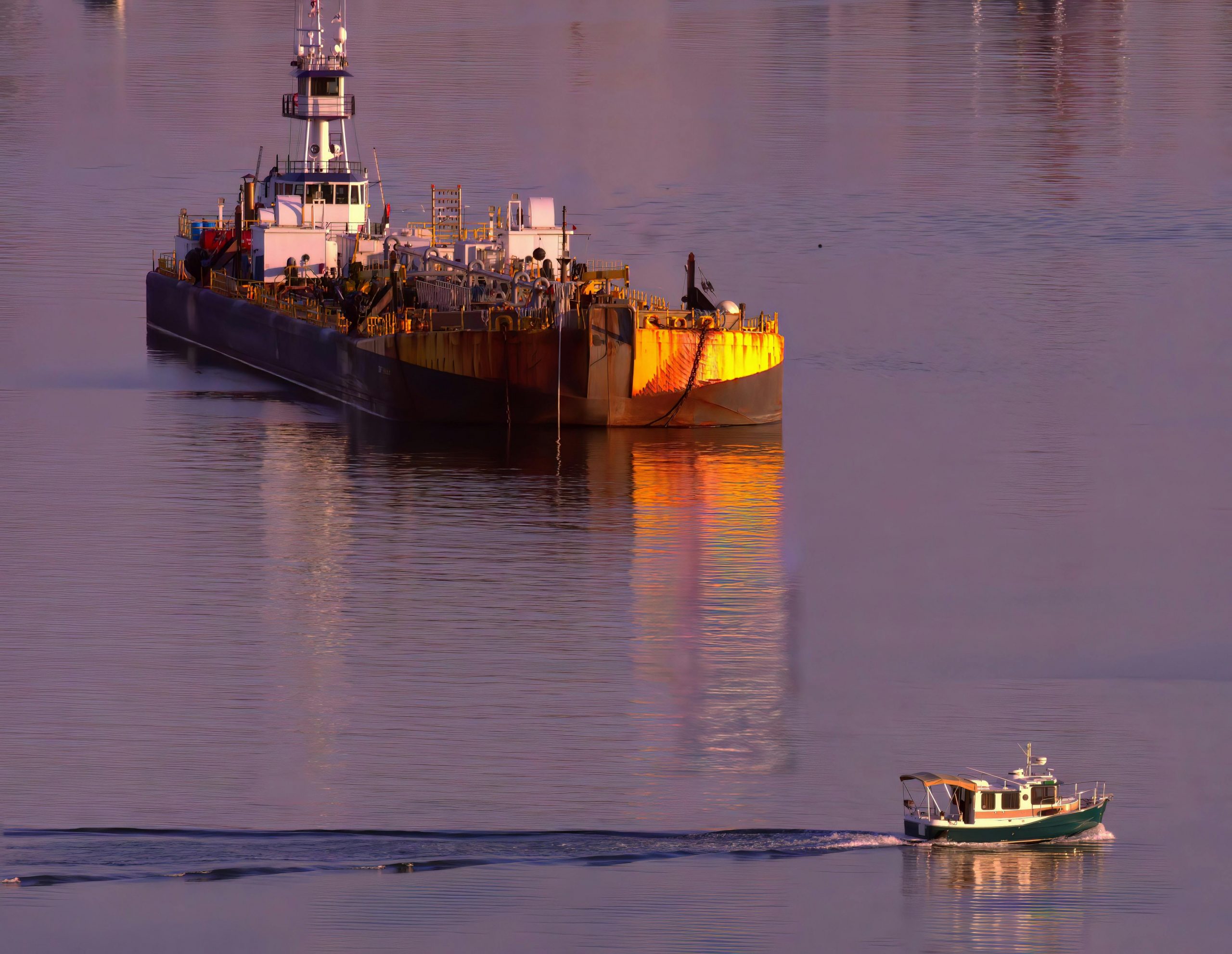A flash of dazzling blue and orange, a deep plop sound and the kingfisher emerges from the brown water with a tiny fish that promptly wriggles a headlong dive back into the water below. Mentally conflicted, feeling both relieved for the fish whilst simultaneously sympathising with the hungry kingfisher, I’m allowed a few seconds to admire its plumage before it darts away upriver. Structural colouration they call it; a trick of the light, where a creature appears more colourful than it actually is. A kingfisher’s back appears vivid metallic blue, but in reality, the feather pigments are a murky brown!
18.15 – Arwen, my Welsford designed ‘navigator’, gently tugs the Treluggan Boatyard pontoon cleats high up the river Lynher in SE Cornwall. I’m completing log book notes to a soundscape of snuffling ducks, gurgling river and soulful country music that drifts across swirling backwaters from one of the live-aboard barges further downriver. I’ve successfully arrived by sail and oar, without recourse to the outboard, surviving an encounter with an angry goose and narrowly avoiding a concussion from an unforeseen gybing boom. All in all, it’s been a good day.
Notes finished, I stroll the pontoon side stepping the upturned 6’ dinghy, a pile of old canvas tarpaulins and an antiquated portable petrol generator. Laughter, tinkling glasses and the high-pitched screech of a distant disc grinder waft across the sunken hulk of an old cabin cruiser in the adjacent muddy lagoon. Beneath my feet, rickety timber pontoons chained together, have their surfaces covered in chicken wire. Grasses and small shrubs grow in crevices and orangery brown splinters and shards collect in gouges where the wood rots. “Rustic pontoons, serviceable and charming” surmises inner voice.
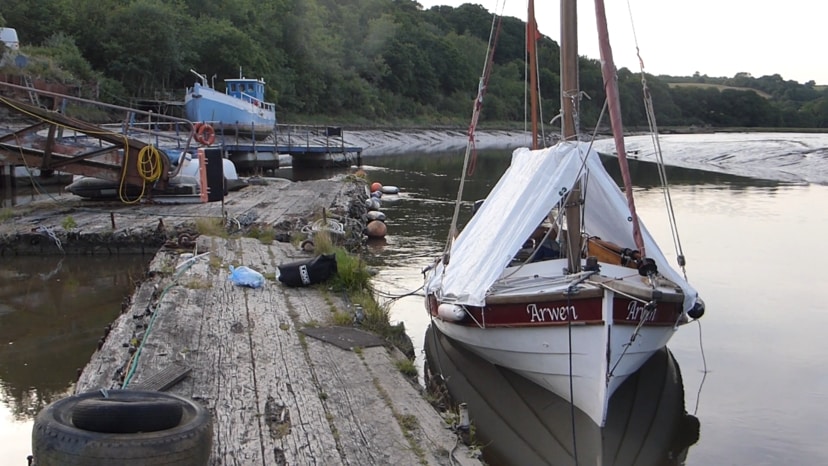
Back aboard Arwen, the re-furled standing lug sail on the sprit boom is rested on boom crutches across the rear thwart, and slowly I unroll the white tarp tent from mast to mizzen mast; stretching its bungee cord hems over hooks beneath the lower rub rails. Whilst inquisitive ducks arrive hoping for some tasty titbit, I slot the 15mm diameter flexible PVC water pipe into two deck loops attached to either coaming. The tarp sides push out to give me plenty more head room.
Floors and thwarts are sponged clean, equipment stowed correctly and then I lift the galley box onto the port thwart, unclipping the lid and laying it top down on the opposite seat. A pause, to take delight in the little ‘vumph’ sound that occurs as the meths ignites and the burner flame in my beloved Trangia suddenly glows blue. Within five minutes, a cuppa has been made and chopped carrots and broccoli set to simmer. Bowl, cutlery, fruit and custard tubs are laid out on the upturned galley box lid and a short time later the cooked veg is scooped into a waiting bowl and I’ve gingerly lowered a foil ‘boil in the bag’ meal into the pot.
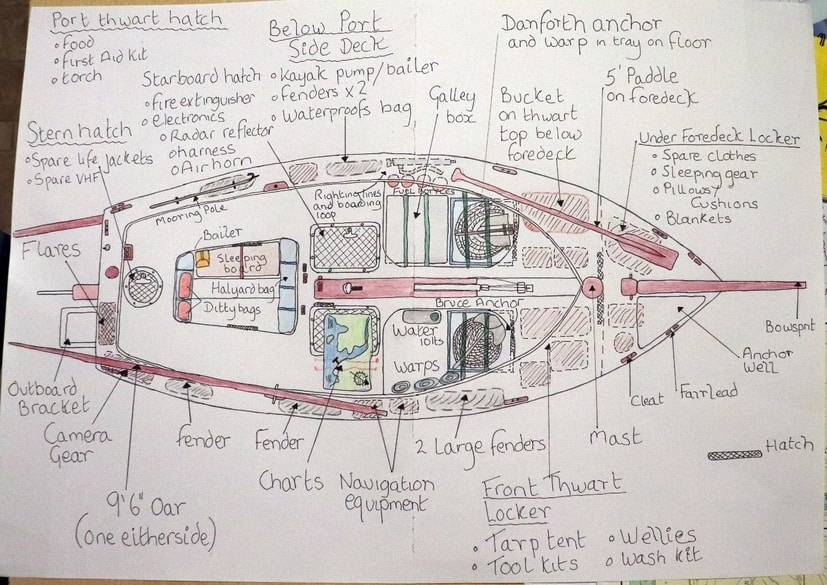
‘Equipment stowed correctly in Arwen……when things go according to plan!’
18.45 - Spag Bol and veg – a modest meal accompanied by lovely views of a narrow, muddy, wood lined valley. Country music, ducks chasing tiny shrimp, mallards waddling up steep muddy banks and slithering back down again. Who says ducks don’t know how to have fun! Occasional mullet splash against Arwen’s hull. The starboard channel marker pole behind me looks far closer than it was at high tide. An optical illusion, of course. It hasn’t moved, but the mud bank beyond has gained significant height. It’s a good 1.5m above me.
After clearing up, I amble the deserted boatyard in its former quarry. Lots of boats shored up by props, anchors and chains dropping off bow rollers to be neatly coiled and stored on wooden pallets below. A few boats for sale, some in better condition than others. Tractor, a large sling haul-out trailer, toilet block and work sheds. The smell of fresh paint, varnish and oil. One or two unloved, overgrown boats in forgotten corners. It’s a delightfully well ordered, traditional yard.
As the sun sinks behind low Cornish hills, I assemble the plywood sleeping board; a shamelessly ‘stolen’ idea from another ‘navigator’ owner, Joel Bergen. The platform lives in the aft cockpit floor well and rests on simple plywood ‘squares’ which when inserted into each other make a set of stable ‘X’ support columns. From the under-foredeck locker comes self-inflating roll mat, fleece blanket, several scatter cushions and finally Goretex bivvy bag and four season down sleeping bag (the latter, very old, crumpled and tea stained but still fully serviceable - “a bit like its owner” says ‘her-indoors’!
Now the cockpit is cosy and homely! Galley box has been packed away and electronics are charging off portable power banks on the starboard thwart. Phone, head torch, VHF radio, foulies and PFD are close to hand. My last act for the night, checking mooring warps and quickly scrutinising tomorrow’s pilotage notes in my little yellow notebook. ‘High tide, 05.30 tomorrow; away by 06.30 latest’.

‘Now the cockpit is homely and cosy’
Sometime after 22.40, Arwen comes to rest on the channel bottom. I don’t feel a thing. I’m well gone in the land of Narnia, chatting to Aslan about climate change...as you do.
04.30 - Dawn and with it the growing awareness of faint light through the tarp weave. Cockpit interior slowly emerges and cool damp air touches my exposed face. Drops of condensation coalesce overhead and succumb to gravity. Drip. Drip. Phew! Tiny splashes on the keelson below are accompanied by an overwhelming sense of relief. A sudden wet awaking avoided, but only just! Semiconscious, I hear our ‘feathered alarm clock friends’ (RSPB) start their early dawn chorus. In this cold, dim morning light, effort in foraging is wasted. Insects have yet to warm up and early morning flight risks attracting a predator returning from a late-night foray across the woods and creek-side meadow. Snuggled in my sleeping bag, I listen to this ‘avian Glyndebourne’. As Henry Porter in ‘The Guardian’ newspaper once remarked “to be alone in the dawn chorus reminds us of how precious life is”.
04.45 – “Time and tide wait for no man” yells inner voice. A light peach glow creeps across thwarts and cockpit. The rapidly ebbing spring tide risks an imminent, embarrassing grounding on the mud if I don’t get a move on. Sleepy brain coerces body limbs into shedding warm night time attire for slightly ‘damp’ day clothing; that I’d stored inside my bivvy bag - to keep it all dry! An inelegant squirming ‘cockpit dance’ begins. I’m trying to avoid condensation transferring to bare torso and new day’s clothes; early mornings under a tarp tent can be brutal!
Tent rolled away, a first glimpse of the emerging day with gently flowing river and tendrils of fine mist above warm waters. The first hints of pink and gold caress the upper branches of mighty oaks high on the valley sides. Victorian art critic John Ruskin once declared, “A dawn, truly observed, is a moment of birth, a call to action for the day. Let every dawn of morning be to you as the beginning of life”. Lovely words, but it’s unlikely he ever had to catch an early morning rapidly ebbing tide. I’ll forego intriguing contemplation about the ‘beginning of life’!
05.20 - I paddle Arwen downriver to the wider channel, unship the oars but then rest a moment to appreciate the uplifting views. Early morning clouds, tinged flamingo pink, reflect in the still glassy waters; a magical mirror image occasionally obscured by gossamer wisps of morning mist. Drifting downriver with the ebb and an occasional oar stroke, a faint, faint northerly breeze fills and falls. The mizzen flutters for a few precious seconds.
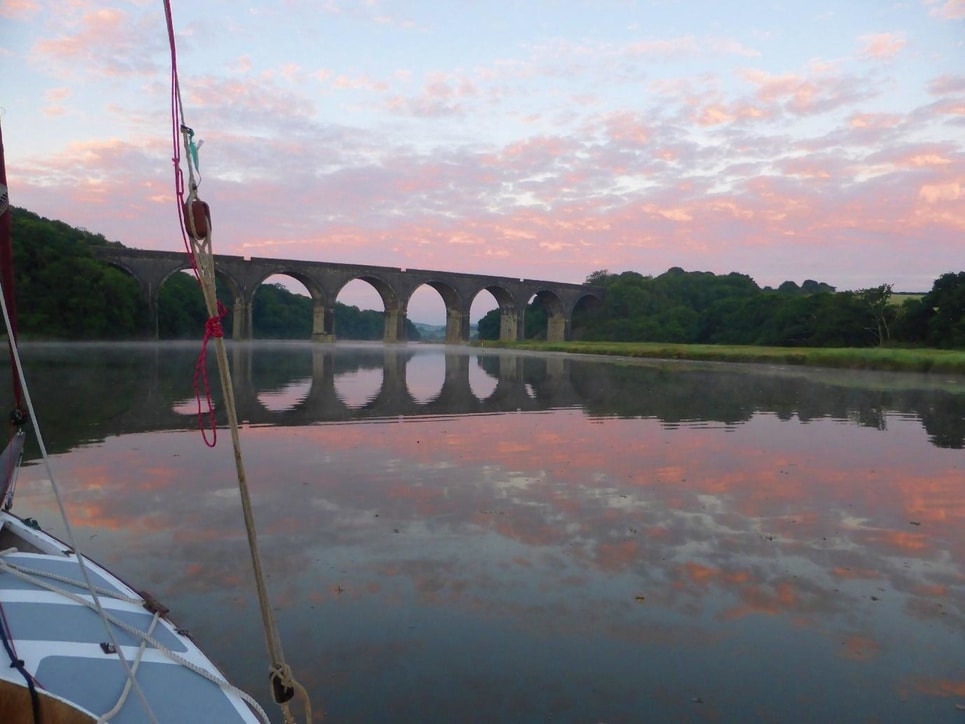 ‘Early morning clouds, tinged flamingo pink, reflect in the still glassy waters; a magical mirror image occasionally obscured by gossamer wisps of morning mist’.
‘Early morning clouds, tinged flamingo pink, reflect in the still glassy waters; a magical mirror image occasionally obscured by gossamer wisps of morning mist’.
The return down river to Henn Point on the Tamar is a slow languorous drift interspersed with short bursts of rowing and eating the leftover marmite and cheese sarnies from the day before. I’ve eaten worse! East of Redshank point I’m privileged to witness a truly magnificent sunrise, where smooth surface waters reflect yellow tinted clouds and early morning high plane vapour trails. A few miles downriver, HMS Brecon lies silhouetted. It’s breath-taking.
07.50 - ‘75M, 0.45nm Trematon red can to Ince green buoy’. The anchored Drascombes, passed the previous day in sheltered northern bays, have gone. Off Black Rock, I hoist the main (“slacken the snotter, move boom for’ard” prompts inner voice) and catch the weak north westerly breeze which carries us downriver past remaining channel buoys where local cormorants sunbathe. Startled, wings outstretch and heads bob vigorously, each bird decides whether to remain or take flight as Arwen and I silently glide by. ‘Ince Castle to Antony buoy 48M, 0.9nm’ says the annotated sketch map in my little yellow book.
Our favourite Henn point mooring buoy is free. It’s time for breakfast. The two small terns occupying the buoy courageously attempt to move me on, holding their ground to the last possible moment before wheeling upwards and dive-bombing Arwen for a few minutes. A peace offering of half my last cheese and marmite sarnie is refused, the tern’s shrill calls indignant screeches of protest. I feel guilty until an accurate poop bomb splatters Arwen’s foredeck; revenge secured, terns fly south to a neighbouring barge, from where they continue to screech their protestations.
09.15 - Under the partially erected tarp tent, I open the galley box, rustle up a brew and cook bacon and eggs. The large MOD Police boat on morning patrol turns west to languidly head up the Lynher to Jupiter point.
I’m surprised to find the bow of the Police boat no more than 3m off my starboard quarter a few minutes later. Wow, I didn’t hear them coming!
“Good morning Sir. Saltash Sailing Club have sent us across to collect the £30 overnight mooring fee you owe them” says the black clad, rather intimidating Policeman. He’s even got his dark sunglasses on!
“I’m sorry, I’ve only just arrived. I wasn’t aware there was a need to pay a mooring fee for a temporary half hour stop Officer.”
“Ah well sir, you understand it is very expensive to lay and maintain these moorings; costs have to be recouped. Do you have proof that you have only just arrived Sir?”
Oh my – I am not expecting this!
“I stayed up at Treluggan boatyard last night if you would like to ring them.”
“Ah Sir, a bit early for that; they won’t be open yet will they – so do you have any other proof sir, otherwise we will have to charge you.”
“Forgive me for asking but do the MOD Police always help out private yacht clubs – shouldn’t you be patrolling the frigates?”
“I’m sorry sir! Yes, we do help out our neighbours and they share intelligence with us Sir, now what proof do you have that you were up Treluggan last night Sir – do you have a GPS track we can download for example, Sir?”
Suppressing exasperating inner voice, (now isn’t the time to admit I have problems remembering where speed, compass direction and navigation tracks are on my handheld Garmin), I dig my heels in, refuse to pay and explain slowly with as much ‘irritated teacher tone’ as I can muster this early in the morning, that when I pass their pontoon later, I will call in at the club and sort the matter out with them face to face.
The grin across the officer’s face is from ear to ear. Turning to a colleague, he calls “Told you I’d get him in the end.” Lots of laughter all round and then an introduction. “The Missus says hello, sends her love and says we are to look out for you on our section of the Tamar.” Turns out ‘his missus’ and I worked together for many years. I never met her husband but knew he was a police officer; she just failed to mention he was MOD police!! With a wave and several hearty guffaws, the police crew ease away and carry on their slow tour of the Hamoaze; ever-watchful, looking for the abnormal and the non-routine. After this adrenaline surge, I need a lie down. The sun rises higher, breezes build and the tide ebbs faster.
I wake with a start to find it’s nearly 10.55, almost two hours have passed. On the Tamar bridges traffic is in full flow and a train lumbers eastward. I check the weather and river conditions. Yellow notebook says ‘low tide around 11.40’. “Don’t panic Steve, plenty of time, wait awhile more. Let the tide fill.” Rarely is inner voice this soothing but I brew another cuppa and keep a watchful eye on the MOD boat, who watches me watching them watching me! How terribly disconcerting!
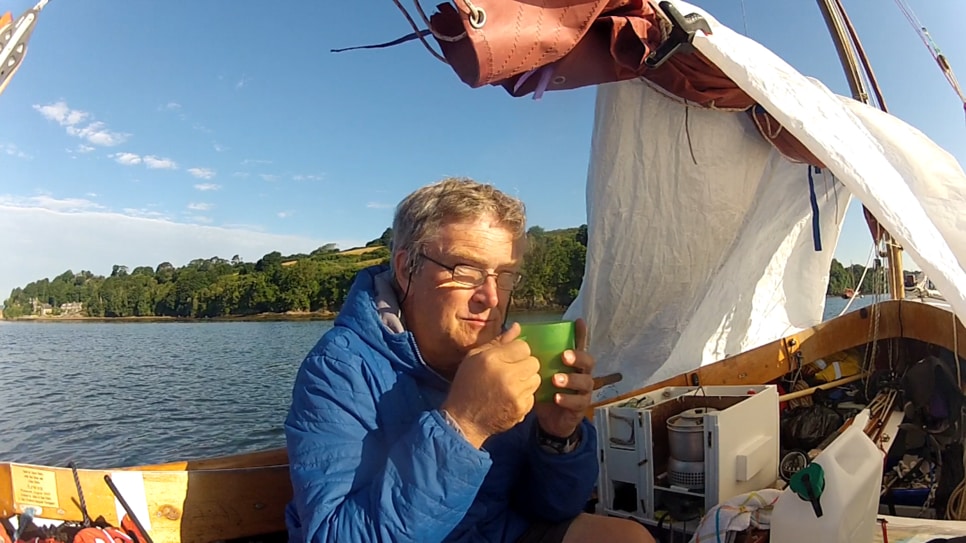
‘Another cuppa soothes frayed nerves’
The river Tamar is the border between Devon and Cornwall, a place where local disputes break out over how one should have scones, jam and cream. Mentioned by Ptolemy in the 2nd century, the word Tamar means ‘great water’ and with its source less than 6 miles from the north Cornwall coast, it’s another of those geographical peculiarities that I so love; for the Tamar flows south instead of north due to a particular topography.
Woken from my musings by shouts and noise from the Tamar River Sailing Club; a boat is being swung back into the water on a small crane, an army of hard hatted men wrestling bow and stern ropes to keep the boat aligned with the quayside wall. Little do I know now that tomorrow I’ll be making a ‘serious emergency stop’ at their pontoon!
For now, though, sailing under the Tamar bridges is exciting. Orange clad workmen swarm over scaffolding like ants, for the Brunel Railway Bridge, completed in 1859, is getting a makeover. Clear of the bridges, past the free slipway and public pontoon at Saltash Jubilee Green, we leave the mooring trots astern. Assisted by SW breezes and a flooding tide Arwen makes 3.4 kts, her mainsail almost fully out against the starboard shroud. Adjacent starboard channel buoys have just re-floated but Kingsmill and Tamerton Lake mudflats have yet to be fully covered. I constantly scan aft for sudden wind gusts whilst keeping a cautious eye on the nearly fully raised centreboard, my ad-hoc depth sounder. Sat up on the port quarter side deck, I’m thankful for Arwen’s excellent stability.
Anticipating a potential wind shadow off Neal Point, I helm Arwen to a more easterly channel position. “Stick to the faster flowing mid-channel Steve.” A train rumbles across the Tavy river bridge; a tributary to Bere Ferrers that I need to explore, but not today. I’m not confident of how much tide has filled that creek.
12.50 – ‘Weir Point yellow buoy to Cargreen starboard pole – 332M, 0.5 nm’. Amidst the Cargreen mooring trots I lose the wind, drift close to some expensive looking yachts and only just ghost through by the skin of my teeth. Yikes! Two hundred metres later, miscalculating my position, I run out of water depth. I’d been admiring the little wooden boats on their moorings. “Was that ‘Spirit of Mystery’ over yonder? Haven’t learnt your lesson from yesterday have you! Such a muppet - keep your eye on the channel” says withering inner voice! I paddle punt myself off the muddy shore, quickly raise mainsail and throw in a rapid tack to regain deeper water once more. Cargreen, once a thriving flower and fishing port with a ferry across to Bere Ferrers, falls abaft as I ping another SPOT ‘OK’ message to ‘her indoors’.
13.35 – At Weir Quay boatyard where the mud banks here dry out at 2.4m above low water, the tide just laps the pontoon base. “That bridge up to land is too steeply inclined; it’s a very shallow muddy stream to that pontoon - don’t do it Steve; pass by.” Once more, inner voice and courage fail me and I sail by. At worse, it would have been a temporary grounding a few metres off the pontoon until the tide floated me! Nothing ventured, nothing gained or learned! Regret, self-chastisement. A pity, another place left unexplored; maybe next trip then.
Variable 4kt SW breezes blow us into the first bend of a large meander that doubles back on itself. I adjust snotter and luff tension to gain more ‘bag’ in the sail. ‘Hug the northern shore – deeper water’ says notebook. I need a plan. “Reach around bend, rapid short tack down southerly channel stretch; gybe onto northerly run as the meander straightens to Halton Quay.” Well that’s the theory. I reach for the ‘nerve calming’ Murray Mints; I’m out of ‘comforting’ cheese and marmite sarnies! “No outboard, sail and oar; no outboard, sail and oar.” I’m chanting to myself and frankly, that’s weird!
Barely making 1.3kts in a fading, sultry breeze; main-sheet hangs from aft boom, dragging in the water; the sail’s lifeless out over the starboard beam. “Sloppy seamanship Steve” chides inner voice thus prompting me to grab a handful of slack sheets back into the boat. Becalmed moments later on this outside bend, two metres from the muddy shore, I start to drift backwards at a disconcerting speed and then stupidly attempt to ferry glide backwards to the slower current on the opposite channel side. Easy to do in an open canoe, but here’s the thing – note to self - Arwen is NOT an open canoe!
Reprieved! A whispering breeze across the floodplain moves us forwards once more but ‘the plan’ is out the window. I forgot that faster river flow on outside meander bends might slow the boat’s forward passage speed despite a flooding spring tide push. “Expect the unexpected Steve - dur!” I suck another Murray Mint!
I scrutinise the centreboard over the inner bend muddy shallows whilst simultaneously looking for the hulk of an old paddle steamer hidden away in reeds on the opposite shore. What a sight she must have made in the early 20th century, carrying tourists up the Tamar to Cotehele or Calstock on the big spring tides. The scenery is dramatically changing now as we drift pass old, dilapidated wooden piers, collapsed trees and reed fringed muddy beaches. There is an agricultural, rural calm to the river valley; a tractor chugs past low hooped poly tunnels and herons, suddenly alarmed by our presence, take off skimming low across brown waters, the beat of their long wings rhythmic and steady. Beyond the mud flats with their egrets and oystercatchers lie green fields and yellow splashes of buttercups and celandines. Gloriously striking scenery, the upper Tamar valley is a European Special Area of Conservation and an Area of Outstanding Natural Beauty. I spot an avocet and a curlew.
14.25 – It’s tempting to nosey into that narrow waterway running deep into margin reed beds. A real exploratory adventure but, the channel is barely the width of Arwen’s hull and is choked with rafts of old tangled reeds. “Don’t risk it Steve. You’ll get stuck Steve. You can’t use the outboard in there Steve.” Getting in will be easy, getting out – less so. “Can you oar punt a 15’ boat backwards?” Between reed beds, glimpses of an unexplored natural world and further back, expensive, exquisite cottages in splendid rural isolation. What an amazing place to live.
Glistening mud flats are punctuated by sporadic driftwood tree branches, their silvery bleached twigs reaching skywards like skeletal wrists and forearms. Short tacking proves hard work in light breezes and I run aground twice, missing the shuddering centreboard each time. An old RYA Day Skipper theory course leader of mine had a few adages. “Good pilotage is thinking about the area that’s 10 minutes ahead of where you are in reality.” Um! That ability to spot any hazards missed during ‘passage planning’ research sessions and to formulate safe plans for dealing with them on the hoof. Good at this in the mountains, I’m genuinely hopeless at it out on the water! Go figure!
So it is no surprise to me that once more I fail to anticipate a wind shadow just before the open parkland of Pentille Castle. River current alone carries us past Pentille quayside with its old Victorian bathing hut. 0.7kts! The Castle, built in 1698 and enlarged in 1809 is high above us. Now, an award-winning wedding venue, the gardens and remodelled house were based on a Humphrey Repton ‘Red Book’. I furl the drooping jib, loosen snotter and luff tension a tad more and nudge Arwen towards the lee shore; a forlorn hope that winds will spill down the western bare grassland slopes beyond the quayside and across the channel.
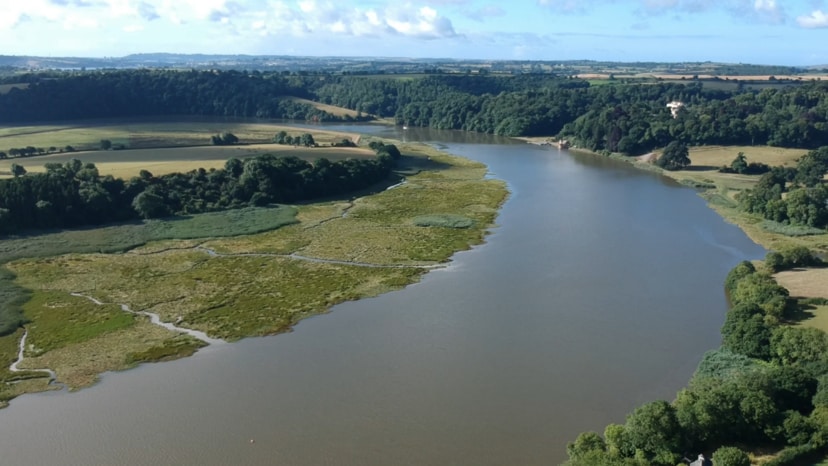
‘Looking back south down the meander loop – Pentillie Castle and its small quay at the waterside are seen in the top right corner area of the photograph.'
15.30 - A few minutes sunbathing and admiring the cottages and farmscape and the rising tide re-floats Arwen. Shifting breezes enable exciting upriver tacking right into the very shallow water. Tacking for speed rather than upriver progress? “Is there a slight downriver sideways slippage in this section of the river, or am I imagining it?”
Between Halton and Cotehele the river narrows considerably and whilst I duck back and fore under the boom, the inevitable happens. My perfectly timed tack run to the very edge ends as a lee shore grounding; the jib sheet catching the forward edge of the sprit boom. I trip over a pile of main and mizzen sheet halyards on the cockpit floor. The bruised knee cap proves painful for the rest of the day. “That will teach you” admonishes inner voice. “Tidy your sheets, trim your sails properly.”

‘Approaching Cotehele Quay’
16.15 - The approach to Cotehele Quay is an exquisite reed fringed channel with distant views across marshes and market gardened hills. A cream tea beckons in the Edgecumbe Arms Tea House. I sail past the quays, execute a ridiculously tight tack back downriver to face into the tide and quickly douse all sails. A few deft strokes of the paddle and I’m alongside the wooden staircase by the deeper quayside; painter is rapidly looped around wooden uprights and with bow and stern warps in hand I’ve bounded up the steps and looped them over convenient bollards.
I’m shocked. What possessed me to try that stunt in such a narrow river? Never in a thousand years will I ever manage that again. The slow realisation of a potential near disaster averted in front of hordes of tourists, by sheer dumb luck rather than skilled judgement, slowly dawns on me. I wobble across to take a peek at ‘Shamrock’ under her tarp tent workshop covers and suddenly, weak kneed, I don’t feel like having a cream tea anymore.
‘Shamrock’. 57’ 6” long, a hold depth of 5’4” and main mast height of 42’. Built in the Stonehouse yard of Frederick Hawke as a ketch rigged Tamar sailing barge in 1899, she is undergoing another restoration by the National Trust and National Maritime Trust. In her heyday, she was considered to be the most advanced Tamar sailing barge ever built, carrying the maximum cargo for her size on the minimum draft at the lowest operating and maintenance costs.
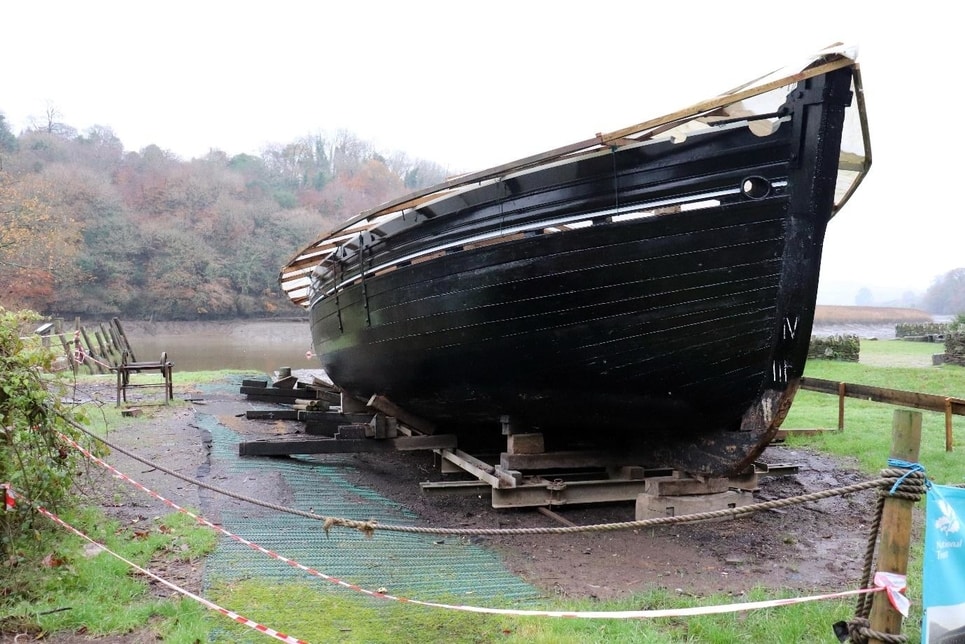
‘A recent photo – showing ‘Shamrock’ now out in the open’.
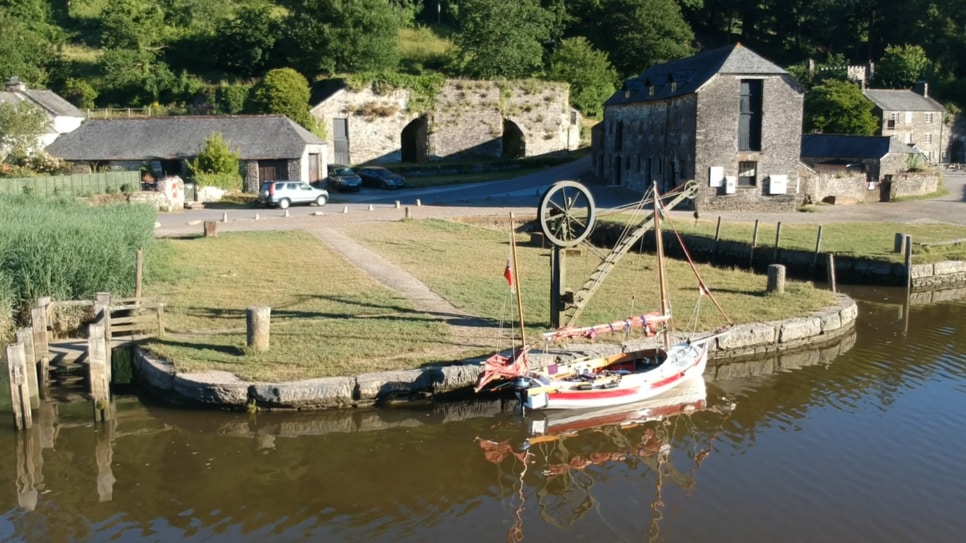 ‘It’s almost high tide, so returning to Arwen, I quickly reccy the steep slipway and adjacent quays and then ‘visualise’ my departure’.
‘It’s almost high tide, so returning to Arwen, I quickly reccy the steep slipway and adjacent quays and then ‘visualise’ my departure’.
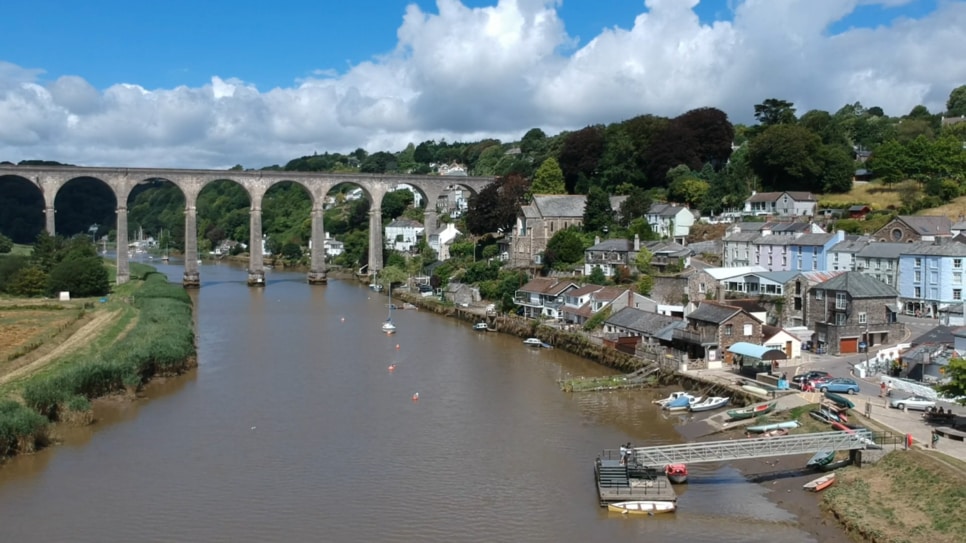 ‘The 120’ high Victorian railway viaduct is stupendous!’
‘The 120’ high Victorian railway viaduct is stupendous!’
 ‘The first part of the return voyage from Calstock….going well…..and then things deteriorated somewhat!’
‘The first part of the return voyage from Calstock….going well…..and then things deteriorated somewhat!’
Past Kingsmill and Tamerton Lakes, Arwen slams and corkscrews up and down, the outboard straining as it lifts and plunges in foamy seas. Dollops of spray hurtle from the bow to be whipped away on the wind. Thirty metres from the central span of the Brunel bridge, an ‘explosive’ crack practically stops my rapidly beating heart. The engine is hanging off the transom, secured by just a 5mm rope that ties it to a cleat on the inside coaming. The outboard bracket has partially snapped – a long horizontal crack from side to side; a piece ‘flaps’ under the weight of the outboard.
Truthfully, I can’t remember what happens in the following five minutes; vague recollections of one hand holding the outboard, the other controlling the outboard tiller, me hanging out over the transom. Somehow, I reach the Tamar Sailing Club pontoon; an ungainly ‘crash’ arrival causing several new dings in Arwen’s paintwork and rub rails!
Panic, terror, overwhelming relief! Several mistakes made earlier almost culminate in a disaster - loss of outboard, damage to transom, near broadside against a bridge support, a potential MOB! A kindly boat engineer arrives with buckle straps. Together we jury rig outboard and bracket so that the engine is firmly re-attached and broken bracket secure and immoveable. His local advice proves invaluable; under reduced engine speed I creep across to the sheltered western shore and hug it all the way down through Torpoint. A ferry pauses to let me struggle through. Off Millbrook lake, in the lee of Cremyll Point, I hook up to a vacant mooring and spend the remaining afternoon waiting for calmer conditions.
18.20 - A chastened skipper later sails past Barn Pool, Drakes Island and Plymouth Hoe, arriving back at QAB Marina several hours later than intended.
04.37 - The wee early morning hours now and I haven’t slept well. I’m reflecting on the lessons learned from this voyage. Have a little more faith in my abilities perhaps? An urgent need to develop better pilotage problem-solving skills and coordination of tidal, wind and topography information in my thought processes. To stretch myself by taking on those more challenging forays into little tributaries and lakes, pushing myself outside my comfort zone? “Adventurous in the mountains and on land expeditions, you are too ‘risk adverse’ out on the water.” Sort out the inaccessible foredeck hatch, repair the hull dents and dings. Alter the oar and seating positions once and for all and lots, lots, more rowing practice in different conditions.
My blog: www.arwensmeanderings.blogspot.co.uk
My YouTube channel: www.YouTube.com/c/plymouthwelshboy
Treluggan Boatyard - http://www.trelugganboatyard.co.uk/
(PS: an apology. In my first article I wrongly called the Treluggan Boatyard manager ‘Graham’. Truly sorry Richard!)
Calstock Boatyard - https://www.calstockboatyard.co.uk/
Other launch sites around the Sound and Tamar
